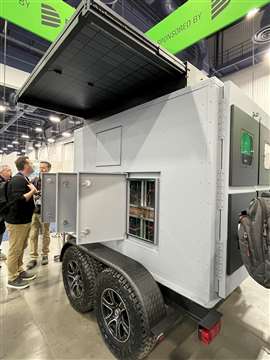Power Up Connect takes BESS mobile
01 April 2025
Power Up Connect has come a long way since it was first established in 2008 in Baltimore, Md. The company started out manufacturing and deploying some of the first mobile charging solutions for cell phones and other devices at community and customer events, and later for disaster and emergency response.
 The mobile BESS features an all-aluminum housing with a 1,100-watt solar panel mounted on top. (Photo: Becky Schultz)
The mobile BESS features an all-aluminum housing with a 1,100-watt solar panel mounted on top. (Photo: Becky Schultz)
Seeking to develop a “green” trailer application, in summer of 2018, the company introduced its first solar charging trailer equipped with a battery energy storage system (BESS). The dual-axle, full-sized charging trailer is capable of charging 60+ cell phone devices, multiple wheelchairs, two-way radios, portable battery packs and other applications on site. A mini version was later introduced with a total of 20 outlets or customizable based on power requirements.
Now, Power Up Connect has taken this a step further and entered the backup power space with a 90-kWh Mobile BESS, the result of an existing relationship with Dominion Energy (Dominion). The system is designed to provide backup power to critical infrastructure during power outages as well as temporary power to project sites.
Scott Calhoun, COO and president of Power Up Connect, said the company previously sold multiple mobile charging trailers to Dominion. Then, about a year and a half ago, the energy provider approached Power Up Connect seeking a “stripped down version” to supply temporary power for applications such as micro data center or substation construction.
“So, that was the first time that we started building an application that was strictly for deployable power,” Calhoun commented. “Dominion funded the project. They’re helping us with grant funding to be able to move this forward, but they’ve invested in us to produce this into their market.”
Towable backup power
 Scott Calhoun (left), COO and president, and Mwamburi “Buri” Mkaya, project director, Power Up Connect. (Photo: Becky Schultz)
Scott Calhoun (left), COO and president, and Mwamburi “Buri” Mkaya, project director, Power Up Connect. (Photo: Becky Schultz)
The result of this relationship is a lightweight, all-aluminum, solar-equipped trailer hosting 90 kW of lithium iron phosphate batteries in the base and three 30-kVA inverters in parallel mounted on top.
“It has three-phase output and single-phase output, and you’re going to be able to charge it at an EV charging station,” said Mwamburi “Buri” Mkaya, project director, Power Up Connect. “Essentially, those three [inverters] in parallel will allow us… to essentially power anything from festivals, event power… backup power for any emergency situation.”
The system can be remotely monitored, allowing for real-time fleet management. A 1,100-watt solar panel on top of the housing is deployable and can power the entire unit from zero to full in roughly two weeks.
“But it’s really for all the subsystems and auxiliary systems,” Mkaya said. “It’s powering the communication [systems] for the remote monitoring. It’s also providing the backup power for the fire safety panel.” This ensures redundancy for optimum safety.
The mobile BESS incorporates all the safety features found in a full-size BESS, he continued – including a commercial fire panel - and will meet the International Fire Code and U.S. fire safety standards.
 The system incorporates 90 kW of lithium iron phosphate batteries and three 30-kVA inverters in parallel. (Photo: Becky Schultz)
The system incorporates 90 kW of lithium iron phosphate batteries and three 30-kVA inverters in parallel. (Photo: Becky Schultz)
The system sits on an oversized, heavy-duty, commercial-grade trailer yet its all-aluminum housing enables a weight of less than 5,000 lb., meaning it can be towed with a light-duty truck.
“It will have all those capabilities that you expect in a stationary BESS system,” Mkaya assured. “We just shrunk it all down and it’s completely modular. So, you’re going to be able to daisy chain them – stack these to the capacity you need – but still keep it mobile so you can pull it around and bring it wherever you need.”
First to market
The 90-kW Mobile BESS was shown for the first time at CES 2025 in early January with plans to be available in the second quarter of this year.
At the time of the event, the system was in the last stages of achieving UL 9540A testing, meaning it will be the first to market to achieve UL 9540A certification, Calhoun said.
“Our factory is waiting for us,” he continued. “Once we pass and we have a concrete list of what that build is going to look like part wise, then we just need to figure out how long it’s going to take to build up. We already have pre-orders of close to 100.”
 The mobile BESS incorporates all the safety features found in a stationary model but in a towable configuration. (Photo: Becky Schultz)
The mobile BESS incorporates all the safety features found in a stationary model but in a towable configuration. (Photo: Becky Schultz)
He anticipated this number to rise steadily. “There are so many different use cases for this type of application for temporary power on site. Because we’ve been selling to a lot of emergency management companies throughout the United States and utility companies, FEMA, Red Cross, natural disaster emergency response, that’s our current initiative.”
However, longer term, he sees the applications growing to “anywhere there is a place that does not have access to power.”
“There’s been a lot of feedback that there’s a need for this, not just in the commercial sector, not just for temporary housing, temporary hospitals after a forest fire... [They] have to have power on site to be able to power their construction equipment that’s out in the field, from clearing debris to also just having power when needed, and a green solution,” Calhoun stated.
“We’re an integrator at the end of the day; It’s our roots. But we are always looking to innovate what we are currently building,” he continued. “So, if we can make it better and more efficient, self-sustaining, then we’re looking at those avenues to be able to provide a better product in the market.”
POWER SOURCING GUIDE
The trusted reference and buyer’s guide for 83 years
The original “desktop search engine,” guiding nearly 10,000 users in more than 90 countries it is the primary reference for specifications and details on all the components that go into engine systems.
Visit Now
STAY CONNECTED




Receive the information you need when you need it through our world-leading magazines, newsletters and daily briefings.
CONNECT WITH THE TEAM









